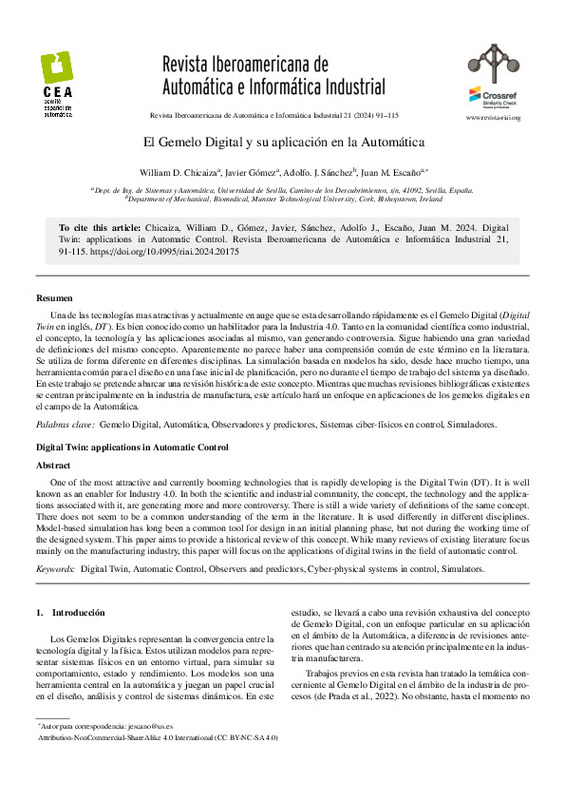JavaScript is disabled for your browser. Some features of this site may not work without it.
Buscar en RiuNet
Listar
Mi cuenta
Estadísticas
Ayuda RiuNet
Admin. UPV
El Gemelo Digital y su aplicación en la Automática
Mostrar el registro sencillo del ítem
Ficheros en el ítem
| dc.contributor.author | Chicaiza, William D.
|
es_ES |
| dc.contributor.author | Gómez, Javier
|
es_ES |
| dc.contributor.author | Sánchez, Adolfo J.
|
es_ES |
| dc.contributor.author | Escaño, Juan M.
|
es_ES |
| dc.date.accessioned | 2024-04-18T11:41:52Z | |
| dc.date.available | 2024-04-18T11:41:52Z | |
| dc.date.issued | 2024-02-16 | |
| dc.identifier.issn | 1697-7912 | |
| dc.identifier.uri | http://hdl.handle.net/10251/203590 | |
| dc.description.abstract | [EN] One of the most attractive and currently booming technologies that is rapidly developing is the Digital Twin (DT). It is wellknown as an enabler for Industry 4.0. In both the scientific and industrial community, the concept, the technology and the applica-tions associated with it, are generating more and more controversy. There is still a wide variety of definitions of the same concept.There does not seem to be a common understanding of the term in the literature. It is used differently in different disciplines.Model-based simulation has long been a common tool for design in an initial planning phase, but not during the working time ofthe designed system. This paper aims to provide a historical review of this concept. While many reviews of existing literature focusmainly on the manufacturing industry, this paper will focus on the applications of digital twins in the field of automatic control. | es_ES |
| dc.description.abstract | [ES] Una de las tecnologías mas atractivas y actualmente en auge que se esta desarrollando rápidamente es el Gemelo Digital (DigitalTwinen inglés,DT). Es bien conocido como un habilitador para la Industria 4.0. Tanto en la comunidad científica como industrial,el concepto, la tecnología y las aplicaciones asociadas al mismo, van generando controversia. Sigue habiendo una gran variedadde definiciones del mismo concepto. Aparentemente no parece haber una comprensión común de este término en la literatura.Se utiliza de forma diferente en diferentes disciplinas. La simulación basada en modelos ha sido, desde hace mucho tiempo, unaherramienta común para el diseño en una fase inicial de planificación, pero no durante el tiempo de trabajo del sistema ya diseñado.En este trabajo se pretende abarcar una revisión histórica de este concepto. Mientras que muchas revisiones bibliográficas existentesse centran principalmente en la industria de manufactura, este artículo hará un enfoque en aplicaciones de los gemelos digitales enel campo de la Automática. | es_ES |
| dc.description.sponsorship | The authors thanks to the European Commission for funding this work under project DENiM. This project has received funding from the European Union’s Horizon 2020 research and innovation programme under grant agreement No 958339. | |
| dc.language | Español | es_ES |
| dc.publisher | Universitat Politècnica de València | es_ES |
| dc.relation.ispartof | Revista Iberoamericana de Automática e Informática industrial | es_ES |
| dc.rights | Reconocimiento - No comercial - Compartir igual (by-nc-sa) | es_ES |
| dc.subject | Digital Twin | es_ES |
| dc.subject | Automatic Control | es_ES |
| dc.subject | Observers and predictors | es_ES |
| dc.subject | Cyber-physical systems in control | es_ES |
| dc.subject | Simulators | es_ES |
| dc.subject | Gemelo Digital | es_ES |
| dc.subject | Automática | es_ES |
| dc.subject | Observadores y predictores | es_ES |
| dc.subject | Sistemas ciber-físicos en control | es_ES |
| dc.subject | Simuladores | es_ES |
| dc.title | El Gemelo Digital y su aplicación en la Automática | es_ES |
| dc.title.alternative | Digital Twin: applications in Automatic Control | es_ES |
| dc.type | Artículo | es_ES |
| dc.identifier.doi | 10.4995/riai.2024.20175 | |
| dc.relation.projectID | info:eu-repo/grantAgreement/EC/H2020/958339/EU | es_ES |
| dc.rights.accessRights | Abierto | es_ES |
| dc.description.bibliographicCitation | Chicaiza, WD.; Gómez, J.; Sánchez, AJ.; Escaño, JM. (2024). El Gemelo Digital y su aplicación en la Automática. Revista Iberoamericana de Automática e Informática industrial. 21(2):91-115. https://doi.org/10.4995/riai.2024.20175 | es_ES |
| dc.description.accrualMethod | OJS | es_ES |
| dc.relation.publisherversion | https://doi.org/10.4995/riai.2024.20175 | es_ES |
| dc.description.upvformatpinicio | 91 | es_ES |
| dc.description.upvformatpfin | 115 | es_ES |
| dc.type.version | info:eu-repo/semantics/publishedVersion | es_ES |
| dc.description.volume | 21 | es_ES |
| dc.description.issue | 2 | es_ES |
| dc.identifier.eissn | 1697-7920 | |
| dc.relation.pasarela | OJS\20175 | es_ES |
| dc.contributor.funder | European Commission |








